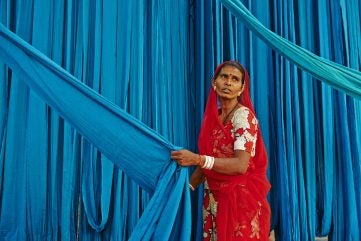
RBC expects India’s “largest” textile event Bharat Tex, currently happening in the capital from 26 to 29 February, to attract global textile leaders and possibly result in the signing of 46 memorandum of understanding (MOUs) and international partnerships.
It noted that while the Indian apparel sector is currently focusing on modernising the sector and building new manufacturing plants, the emphasis should be on the need to boost productivity to bolster the sector’s strength.
The consulting firm stated that despite the “enormous” improvement potential, Indian garment exports have been oscillating around $16-17bn for the past five years.
Quoting the country-wise export figures from the World Trade Organisation (WTO), RBC pointed out that given the tough economic conditions and lower global demand, garment industries in Bangladesh and Vietnam have fared well in comparison to India.
As per WTO data, both Bangladesh and Vietnam have seen growth in export value from 2018 to 2022, with Bangladesh at $45.3bn export value and Vietnam at $35.3bn.
While India saw a comparatively flat increase in export value from $16.5bn in 2018 to $17.7bn in 2022.
RBC explained that post covid-19, the Indian apparel industry has not been able to bounce back as geopolitical developments have also affected global consumption and international trade.
According to the consulting firm, the market outlook in the immediate future looks sombre.
Dr Rajesh Bheda, managing director of RBC and chairperson of Fashion Technology at National Institute of Fashion Technology (NIFT), believes that despite India having plenty of raw material materials, technological expertise, a rich textile manufacturing history and availability of human resources, the country’s performance in the international market doesn’t match its potential.
Bheda said: “The current value of RMG manufacturing in India is estimated at $52bn, $17bn for exports and approximately $35bn for the domestic market. We at Rajesh Bheda Consulting are of the firm belief that the Indian apparel manufacturing industry has immediately available improvement potential of 15% which can be realised within the next 12 months. This means the industry as a whole has a productivity improvement potential worth $7.8bn in the next 12 months.”
One of the major reasons for not meeting the potential, as Bheda describes it, is the low productivity level in garment manufacturing and its impact on competitiveness.
He elaborates: “The average efficiency level in Indian apparel manufacturing is estimated at 45-50% compared to 60-65% of China and Vietnam.”
Is the potential achievable?
RBC estimated productivity improvement potential to have been pegged at a “modest” 15%. The consulting firm believes it to be a reasonably achievable target. It notes some key evidence to support this claim:
- Several productivity improvement projects in the Indian garment factories, facilitated by various consulting firms including RBC in the recent past, have resulted in 10 to 25% productivity improvement.
- Upskilling initiatives for experienced workers using the Low Performer Improvement methodology of RBC, have resulted in an average 20% reduction in process time of individual workers leading to increased worker productivity in 14 Indian factories.
- The project Benefit for Business and Workers, supported by UK Aid implemented by RBC and Impactt Limited in India and Bangladesh for the supplier factories of high street brands from the UK has resulted in 26% productivity improvement in 32 factories from manufacturing hubs across India.
- The results of the research, ‘Productivity in the Indian Apparel Manufacturing: Paradigms and Paragons’ by Dr Rajesh Bheda, based on the study of 61 factories concluded that, the average apparel manufacturer in India can improve labour productivity by 50% with the implementation of productivity improvement strategy.
The consulting firm underscored the importance of manufacturers in implementing best practices in industrial engineering, human resource management and quality systems. It further highlighted that achieving a productivity improvement of about 15% in garment factories within a year is “highly achievable.”
RBC advised industry associations to take a focused approach in promoting productivity improvement in its member factories, emphasising the urgency of supporting productivity improvement efforts on the part of the government as well.
RBC further stated that a more productive garment manufacturing industry for the domestic and export markets will also support employment creation and ensure that India does not lose the domestic market to cost-competitive players like Bangladesh.



